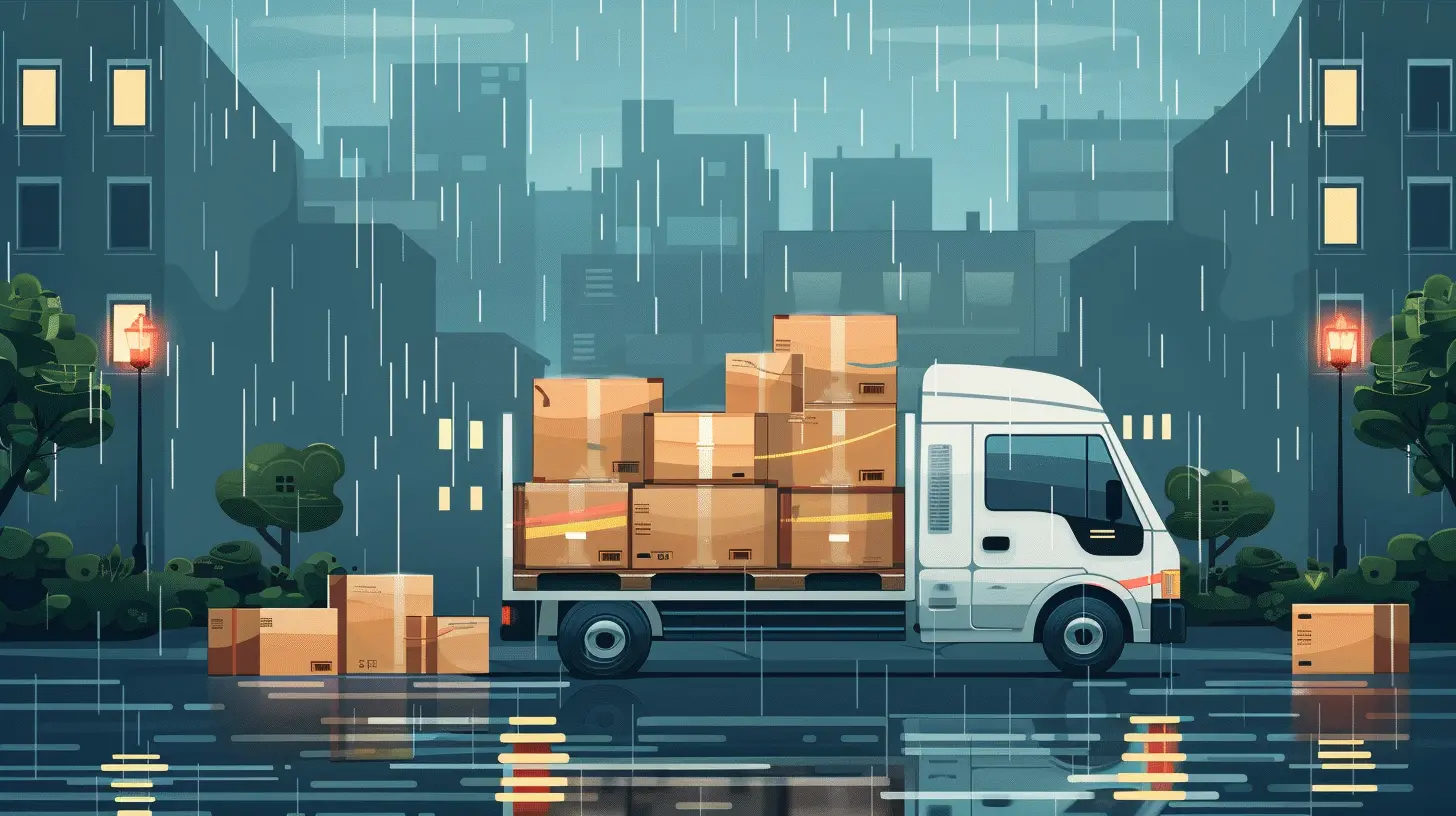Moving in Bad Weather: How to Protect Your Belongings
12 October 2025
Moving is stressful enough without Mother Nature throwing a tantrum. Whether it's a downpour, heavy snow, or blistering winds, bad weather can turn moving day into a nightmare. But don't worry—there are ways to protect your belongings and make sure everything arrives safely at your new home.
In this guide, we'll walk you through some must-know tips and tricks to keep your items safe and dry, no matter what the sky decides to throw at you. 
1. Plan Ahead Like a Pro
The best way to combat bad weather on moving day? Plan ahead. Keep an eye on the weather forecast and prepare accordingly. If you have the flexibility, consider rescheduling your move if extreme weather is expected. However, if changing the date isn’t an option, take the necessary steps to weatherproof your move.Start gathering supplies like plastic sheets, waterproof bins, and heavy-duty tape. Trust us, these little investments could save you from a big disaster. 
2. Use Waterproof Packing Materials
Cardboard boxes and rain (or snow) are not a good mix. If the forecast looks gloomy, try swapping out traditional moving boxes for plastic bins with secure lids. They’re waterproof, sturdy, and reusable—perfect for rainy or snowy moving days.If plastic bins aren't an option, reinforce your cardboard boxes with:
- Plastic wrap – Cover the boxes entirely to prevent moisture from seeping in.
- Garbage bags – Line the inside of your cardboard boxes with garbage bags for extra protection.
- Packing tape – Use high-quality tape to seal all edges and prevent water from getting inside.
It’s a hassle, but a little extra effort here can go a long way in protecting your valuables. 
3. Keep Fragile Items Extra Safe
Bad weather means extra chances for slips, drops, and accidents. Fragile items like glassware, electronics, and artwork need extra padding. Bubble wrap, foam peanuts, and towels can absorb shocks and keep your breakables safe.Also, consider double-boxing fragile items. Place the item in a smaller box with padding, then place that box inside a larger, well-padded box. It’s like giving your valuables a winter coat. 
4. Create an Assembly Line for Efficiency
Nobody wants to stand outside in the rain with an armful of boxes. If you have a team of helpers, set up an efficient system:- One person inside preps the boxes and brings them to the door.
- One person outside (under an umbrella or pop-up tent) transfers the boxes quickly to the moving truck.
- One or two people inside the truck arrange and stack the items properly.
This method minimizes exposure to bad weather and keeps things moving smoothly.
5. Protect Your Furniture
Furniture is often the hardest thing to protect from bad weather. You don’t want water seeping into your couch or damaging that beautiful wooden dresser. Here’s how to protect furniture from the elements:- Use plastic wrap – Cover upholstered furniture with plastic sheets or shrink wrap.
- Tarps and blankets – Wrap wooden furniture with moving blankets, then cover them with tarps for waterproofing.
- Elevate in the truck – If your moving truck floor gets wet, place wooden furniture on plastic pallets or cardboard sheets to prevent water damage.
6. Dress the Part
Moving in bad weather is uncomfortable, but the right clothing can make it bearable. Dress in layers, wear waterproof shoes, and don’t forget gloves with a good grip. If you're dealing with snow or ice, wear boots with good traction to prevent slipping while carrying heavy boxes.7. Keep Floors Safe and Dry
One thing people often forget during a rainy or snowy move? Protecting the floors inside both homes. Wet shoes and dirty boots can turn your new home into a slippery mess.Lay down old towels, cardboard, or plastic sheeting on high-traffic areas to prevent mud and water from ruining your floors. If you have movers, ask them to wipe their shoes before entering.
A little floor protection now saves you from a big cleanup later.
8. Be Extra Cautious with Electronics
Electronics and water do not mix. To keep your TVs, computers, and appliances safe:- Wrap them in thick blankets first – This helps absorb shock.
- Cover with plastic wrap or garbage bags – A simple yet effective way to keep moisture out.
- Label them clearly – Mark electronics as "fragile" so they get extra care.
If possible, keep smaller electronics with you in a separate, waterproof bag to avoid exposure.
9. Be Smart About Loading the Truck
When packing your moving truck in bad weather, think strategically:- Load non-water-sensitive items first – Items like plastic bins, metal tools, and waterproof bags should go in first.
- Put fragile and water-sensitive items in last – They’ll spend less time in wet conditions and can be quickly unloaded into your new home.
- Use tarps to cover open sections – If your moving truck isn’t fully enclosed, secure a tarp over the back to keep rain or snow out.
Following this method can prevent unnecessary damage and reduce the stress of unloading in poor conditions.
10. Keep an Emergency Kit Handy
You never know what might happen on a rainy or snowy moving day. Have an emergency kit ready with essentials like:- Towels and extra blankets
- Plastic bags and garbage bags
- Extra packing tape
- A change of dry clothes
- Non-slip mats or salt for icy walkways
- Flashlights and batteries (especially if moving in a storm)
Being prepared for the unexpected can make a world of difference.
11. Drive Carefully and Give Yourself Extra Time
Bad weather can make driving dangerous, especially when hauling a loaded moving truck. Whether you're driving yourself or working with movers, be extra cautious:- Drive slowly and keep extra distance between vehicles.
- Avoid sudden stops or sharp turns.
- If roads are icy, drive in lower gears to maintain better control.
- Use headlights even during the day for better visibility.
Better to arrive late and safe than to rush and risk an accident.
12. Unpacking in Bad Weather
The hard part may be over, but don’t let down your guard just yet. When unloading in bad weather:- Keep plastic sheets handy for covering unprotected items.
- Wipe down wet items before bringing them inside to prevent water damage.
- Avoid piling boxes in wet areas—moisture can seep in quickly.
If you’re moving in during heavy rain, consider bringing in only the essentials first and waiting for a break in the weather to handle the rest.
Final Thoughts
Moving in bad weather isn’t ideal, but with a little preparation and quick thinking, you can protect your belongings and make the process as smooth as possible. Waterproof your boxes, protect your furniture, and keep an emergency kit handy. Bad weather might slow you down, but it doesn’t have to ruin your moving day.If you're working with professional movers, choose a company experienced in handling moves in all weather conditions. A solid plan and the right precautions will ensure a stress-free move, no matter what the skies throw your way.
So, rain or shine, you've got this! Just remember—it's not about avoiding the storm, it's about learning how to move through it.
all images in this post were generated using AI tools
Category:
Moving TipsAuthor:

Kingston Estes
Discussion
rate this article
1 comments
Finn McMahon
Great tips! Moving in bad weather can be challenging, but with the right precautions, you can protect your belongings. Stay positive—this is just a temporary hurdle!
October 13, 2025 at 4:47 AM

Kingston Estes
Thank you! I appreciate your positive outlook and agree that with the right precautions, we can overcome any moving challenge!


